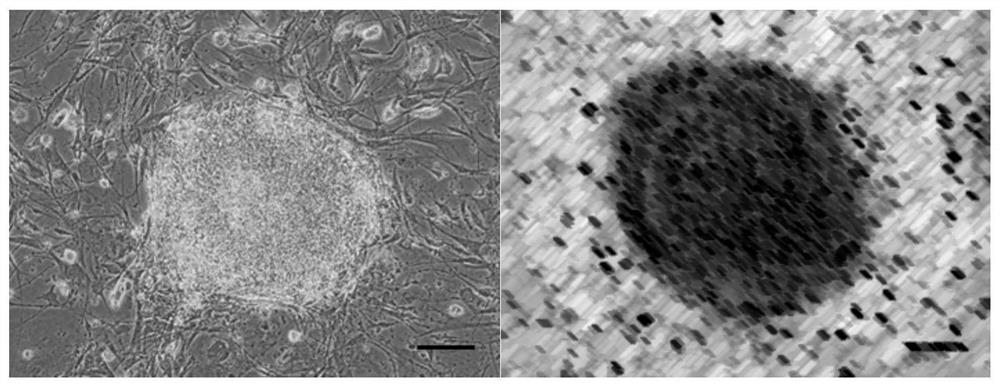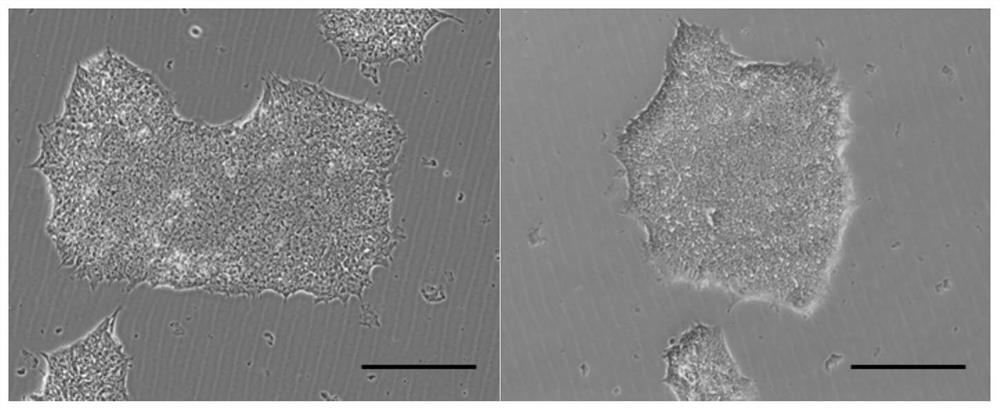Method for reprogramming immortalized lymphocyte line into induced pluripotent stem cells
A technology of lymphocyte lines and lymphocytes, applied in the field of reprogramming immortalized lymphocyte lines into induced pluripotent stem cells, to achieve the effect of reducing the risk of cell tumorigenesis and expanding the value of clinical research
- Summary
- Abstract
- Description
- Claims
- Application Information
AI Technical Summary
Problems solved by technology
Method used
Image
Examples
Embodiment 1
[0043] Example 1 Reprogramming Immortalized Lymphocyte Lines into iPSCs
[0044] (1) The growth state of the lymphocyte line is good, and the density reaches 1×10 6 / mL or so, take 2 mL of cells and centrifuge at 1000 rpm for 5 min at room temperature. Rinse the cells with pre-warmed 1×PBS and discard the supernatant. At the same time, preheat the reprogramming medium. The reprogramming medium is DMEM / F12 medium supplemented with 20% by volume Knockout serum substitute, the final concentration is 1× non-essential amino acids, the final concentration is 1× GlutaMAX, and the final concentration is 50 μg / mL magnesium ascorbyl phosphate , basic fibroblast growth factor at a final concentration of 10 ng / mL.
[0045] (2) Each sample was mixed according to the ratio of Cell Line Nuceofector Solution V 81.8 μL and Supplement 18.2 μL, and the plasmids pCXLE-hOCT3 / 4-shp53-F, pCXLE-hSK, pCXLE-hUL, pCXLE- 2 μg each of EGFP and pCXWB-EBNA1, and mix well to obtain an electrotransfer sol...
Embodiment 2
[0055] Example 2 Identification of iPSC pluripotency gene expression
[0056] (1) Collect normal subcultured iPSCs, extract the total RNA of iPSCs by TRIzol method, then reverse transcribe the total RNA into cDNA, and perform PCR with primers of pluripotency genes SOX2, OCT4, C-MYC, KLF4, and NANOG, and the product Expression was analyzed by agarose gel electrophoresis.
[0057] (2) Using normal subcultured iPSCs, fix them with paraformaldehyde, rinse with PBS, and after blocking, add SOX2, OCT4, NANOG, SSEA4, TRA-1-60 antibodies to each well and incubate overnight at 4 degrees, wash with PBS After rinsing, add the corresponding species fluorescent secondary antibody and incubate at room temperature for 2 hours, then stain with DAPI, rinse with PBS, observe and take pictures under a fluorescence microscope.
PUM
 Login to View More
Login to View More Abstract
Description
Claims
Application Information
 Login to View More
Login to View More - R&D
- Intellectual Property
- Life Sciences
- Materials
- Tech Scout
- Unparalleled Data Quality
- Higher Quality Content
- 60% Fewer Hallucinations
Browse by: Latest US Patents, China's latest patents, Technical Efficacy Thesaurus, Application Domain, Technology Topic, Popular Technical Reports.
© 2025 PatSnap. All rights reserved.Legal|Privacy policy|Modern Slavery Act Transparency Statement|Sitemap|About US| Contact US: help@patsnap.com



